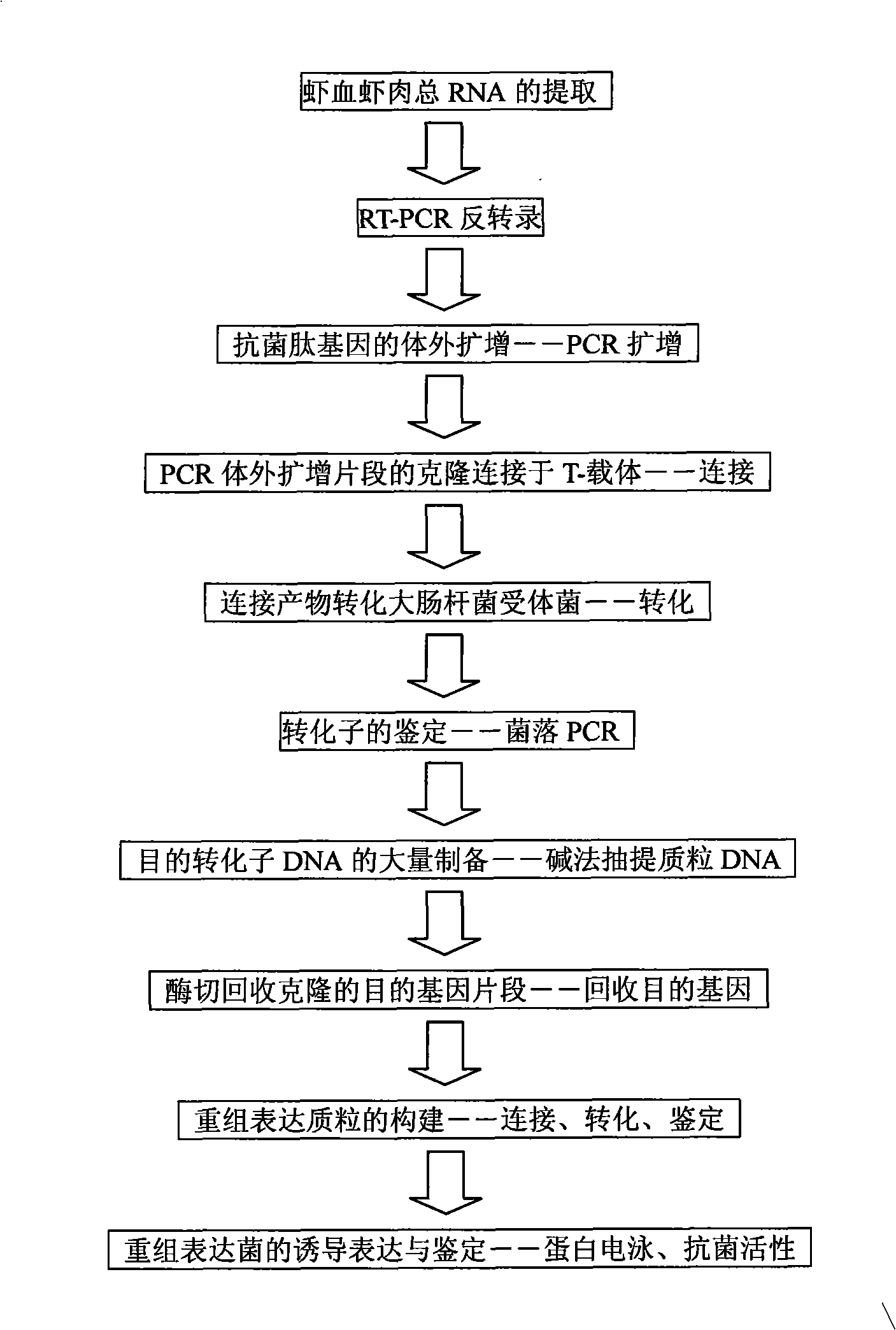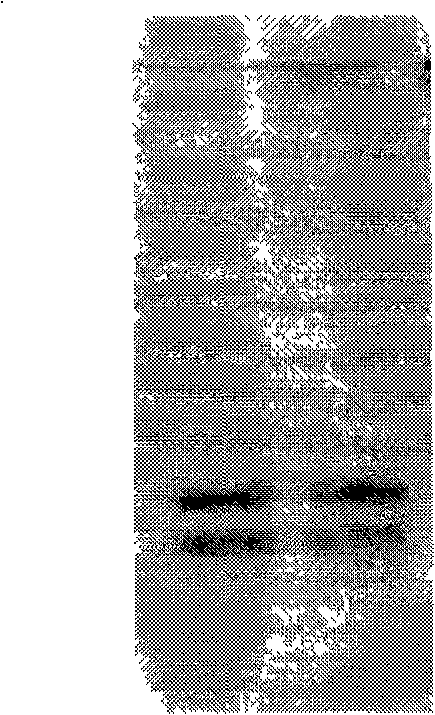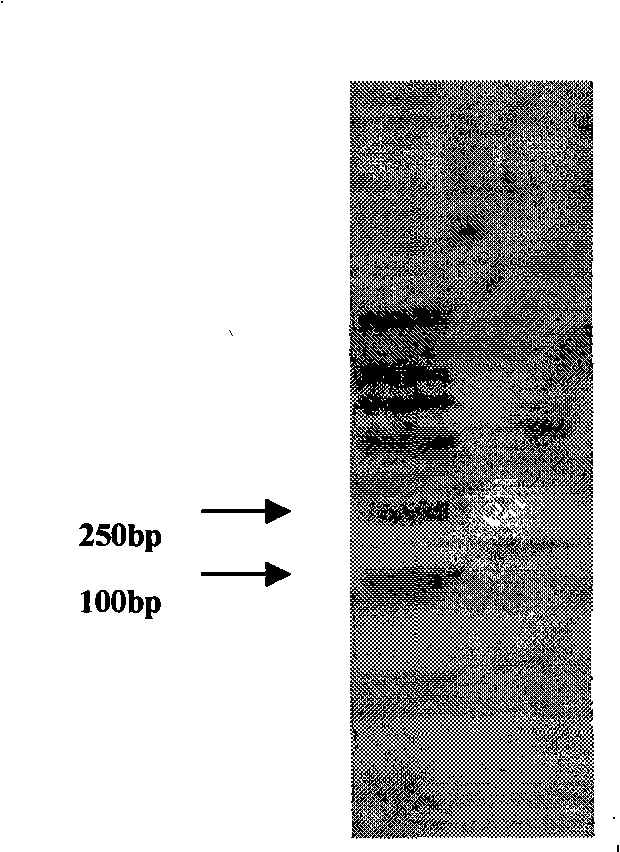Recombination expression and application of shrimp antimicrobial peptide genes in probiotic bacteria
A technology of antimicrobial peptides and probiotics, applied in application, genetic engineering, plant gene improvement, etc., can solve the problems of antimicrobial peptide gene transfer, etc., to promote the production of antibodies, improve immunity and disease resistance, and improve activity Effect
- Summary
- Abstract
- Description
- Claims
- Application Information
AI Technical Summary
Problems solved by technology
Method used
Image
Examples
Embodiment 1
[0049] Construction of Escherichia coli pET28a Expression Vector Containing Grass Shrimp Antimicrobial Peptide Gene
[0050] 1) Establishment of grass shrimp cDNA library
[0051] Take 20 grass shrimps, homogenate, extract with extract (4M guanidine thiocyanate, 25mM sodium citrate, 0.5% laurylsarcosinate, 0.1M mercaptoethanol), extract total RNA with guanidinium salt-phenol-chloroform method, and construct total cDNA library.
[0052] 2) Clone the grass shrimp penaeidin-4 gene by PCR method
[0053] According to the gene sequence of Penaeidin-4 of Litopenaeus vannamei and Litopenaeus setiferus, specific primers Pen4MF1 / Pen4MR1 were designed, and Nde I and Hind III restriction sites were added to both ends of the primers to amplify the penaeidin-4 gene. The primer sequence is:
[0054] Pen4MF1 5'ATCATATGAGCAGCGGTTACACGCG 3'
[0055] Pen4MR1 5'CCAAGCTTTATCCTCTGTGACAACA 3'
[0056] The PCR reaction volume was 50ul, and the amplification conditions were: 94°C for 2min; 30 cyc...
Embodiment 2
[0061] Recombination and expression of the antimicrobial peptide gene of grass shrimp in yeast
[0062] 1) Establishment of grass shrimp cDNA library
[0063] Take 20 grass shrimps, homogenate, extract with extract (4M guanidine thiocyanate, 25mM sodium citrate, 0.5% laurylsarcosinate, 0.1M mercaptoethanol), extract total RNA with guanidinium salt-phenol-chloroform method, and construct total cDNA library;
[0064] 2) Clone the grass shrimp penaeidin-4 gene by PCR method
[0065] According to the gene sequence of Penaeidin-4 of Litopenaeus vannamei and Litopenaeus setiferus, specific primers Pen4MF2 / Pen4MR2 were designed, and EcoR I and Not I restriction sites were added to both ends of the primer to amplify the penaeidin-4 gene. The primer sequence is:
[0066] Pen4MF2 5' ATGGATCC ATGAGCAGCGGTTACACGCG 3'
[0067] Pen4MR2 5'CCAAGCTTCTATCCTCTGTGACAACA 3'
[0068] The PCR reaction volume was 50ul, and the amplification conditions were: 94°C for 2min; 30 cycles of 94°C for ...
Embodiment 3
[0078] Recombination and expression of grass-containing shrimp antimicrobial peptide gene in lactic acid bacteria
[0079] The penaeidin-4 gene was amplified by PCR using the penaeidin-4 gene-specific primers Pen4MF3 / Pen4MR3 with pMD-Pen4-position template and Sac I and Kpn I restriction sites at both ends.
[0080] The primer sequences are:
[0081] Pen4MF3 5' ATGAGCTC ATGAGCAGCGGTTACACGCG 3'
[0082] Pen4MR3 5' CCGGTACCCTATCCCTCTGTGACAACA 3'
[0083] The PCR reaction volume was 50ul, and the amplification conditions were: 94°C for 2min; 30 cycles of 94°C for 30s, 51°C for 45s, and 72°C for 45s; 72°C for 10min.
[0084] Approximately amplified products were detected by 2% agarose gel electrophoresis. The obtained product was purified with a gel purification kit, and connected with the T-vector pMD18T to obtain the cloning vector pMD-Pen4-3 containing the target gene.
[0085] Use Kpn I / Sac I double enzymes to digest pMD-Pen4-3 and lactic acid bacteria expression plasmid...
PUM
 Login to View More
Login to View More Abstract
Description
Claims
Application Information
 Login to View More
Login to View More - R&D
- Intellectual Property
- Life Sciences
- Materials
- Tech Scout
- Unparalleled Data Quality
- Higher Quality Content
- 60% Fewer Hallucinations
Browse by: Latest US Patents, China's latest patents, Technical Efficacy Thesaurus, Application Domain, Technology Topic, Popular Technical Reports.
© 2025 PatSnap. All rights reserved.Legal|Privacy policy|Modern Slavery Act Transparency Statement|Sitemap|About US| Contact US: help@patsnap.com



